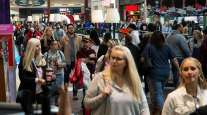Consumer Spending Rises 0.1% in February for Third Month

Personal spending barely increased in February, and the prior month’s advance was revised down as Americans saved more of their incomes.
Spending on goods and services climbed 0.1% for a third month in February, Commerce Department figures showed March 28. January outlays were revised from a previously reported 0.5% gain. Incomes rose 0.2%, pushing the saving rate to a one-year high.
The steady and slow advances in purchases over the past three months show consumers are being cautious about over-extending themselves. Robust labor conditions and savings from cheaper gasoline are nonetheless providing a solid foundation for households, whose spending is underpinning the economy.
“There’s still this sense of more of the same right now — the consumer is still chugging along, not really strong but not terribly weak, either,” said Scott Brown, chief economist at Raymond James Financial Inc. in St. Petersburg, Florida. “Things are a little bit softer than we’d hope to be but still consistent with the economy growing.”
The Bloomberg survey median called for a 0.1% gain in February. Economists’ projections ranged from a 0.2% decline to a 0.3% advance.
After adjusting for inflation, in order to generate the figures used to calculate gross domestic product, purchases increased 0.2% last month after no change in January.
Steady gains in consumer purchases will be needed to keep growth churning. The economy expanded at a 1.4% pace in the fourth quarter, faster than the previously reported 1%, as stronger household spending helped cushion the expansion from weakness overseas, Commerce Department data showed March 25.
Household outlays on services increased 0.3% in February after adjusting for inflation.
The services category, which also includes tourism, legal help, health care and personal care items such as haircuts, typically is difficult for the government to estimate accurately until more information is available in later months.
Spending on durable goods also rose 0.3% in February, while outlays for nondurable goods fell 0.3%.
Disposable income, or the money remaining after taxes, increased 0.3% in February for a third month after adjusting for inflation. The saving rate increased to 5.4% from 5.3% in January.
Wages fell 0.1% in February after a 0.6% advance the prior month.
The personal spending report showed the price index tied to consumer purchases fell 0.1% in February from the prior month. It rose 1% from the same time in 2015. This inflation gauge is preferred by Federal Reserve policymakers and hasn’t met their 2% goal since April 2012.
Stripping out the volatile food and energy categories, the price measure climbed 0.1% from January and rose 1.7% in the 12 months ended in February.
Federal Reserve Bank of St. Louis President James Bullard is among policymakers who are eyeing prospective gains in inflation as a reason to consider increases in the benchmark interest rate.
“I think we are going to end up overshooting on inflation” and the natural rate of unemployment, Bullard said in a March 23 Bloomberg interview in New York. “You get another strong jobs report, it looks like labor markets are improving, you could probably make a case for moving in April.”




